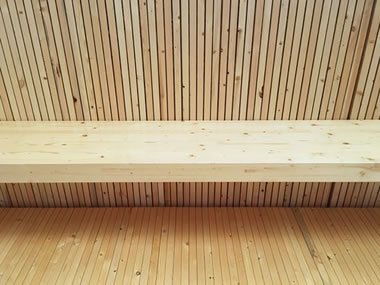Nail-laminated timber (NLT) is manufactured from two-by-four (38 mm x 89 mm), two-by-six (38 mm x 140 mm) or larger boards of wood. Laminations are nailed to each other to create solid prefabricated elements for floor, wall or roof applications.

Species used to make NLT can include:
- spruce-pine-fir
- Douglas-Fir
- yellow-cedar
- western redcedar
Many old post-and-beam heavy timber structures in North America use all-wood floor NLT assemblies. In wood frame buildings, especially those measuring up to six stories, elevator and stairwell shafts can use NLT.
NLT can be a cost-competitive alternative to cross-laminated timber (CLT), but manufacturing NLT can be labour- intensive. It uses readily available lumber materials that do not require sophisticated, expensive facilities for gluing or pressing. NLT does not provide the same dimensional stability and in-plane shear resistance as CLT.
Technical information
Decking assemblies in mass timber construction projects, including tall wood buildings, can make use of NLT. By using different lumber depths, different surface profiles can be generated.
Plywood commonly provides diaphragm action on NLT decks. NLT-concrete composite (TCC), is a system composed of NLT panels connected to a concrete slab through shear connections, taking advantage of the best properties of both materials. A TCC increases the span-to-depth ratio of the slab and improves acoustics. Since NLT contains solid sawn members, it can be treated for outdoor use.
The National Building Code of Canada recognizes NLT assemblies as solid timber construction. The structural design of conventional NLT is specified in the Canadian timber design standard CSA O86 (Engineering Design in Wood). Published by the Government of British Columbia’s Forestry Innovation Investment, key information on architectural and structural uses of NLT is provided in the NLT Timber Design and Construction Guide.

NLT is one of many products used in mass timber construction projects across Canada.